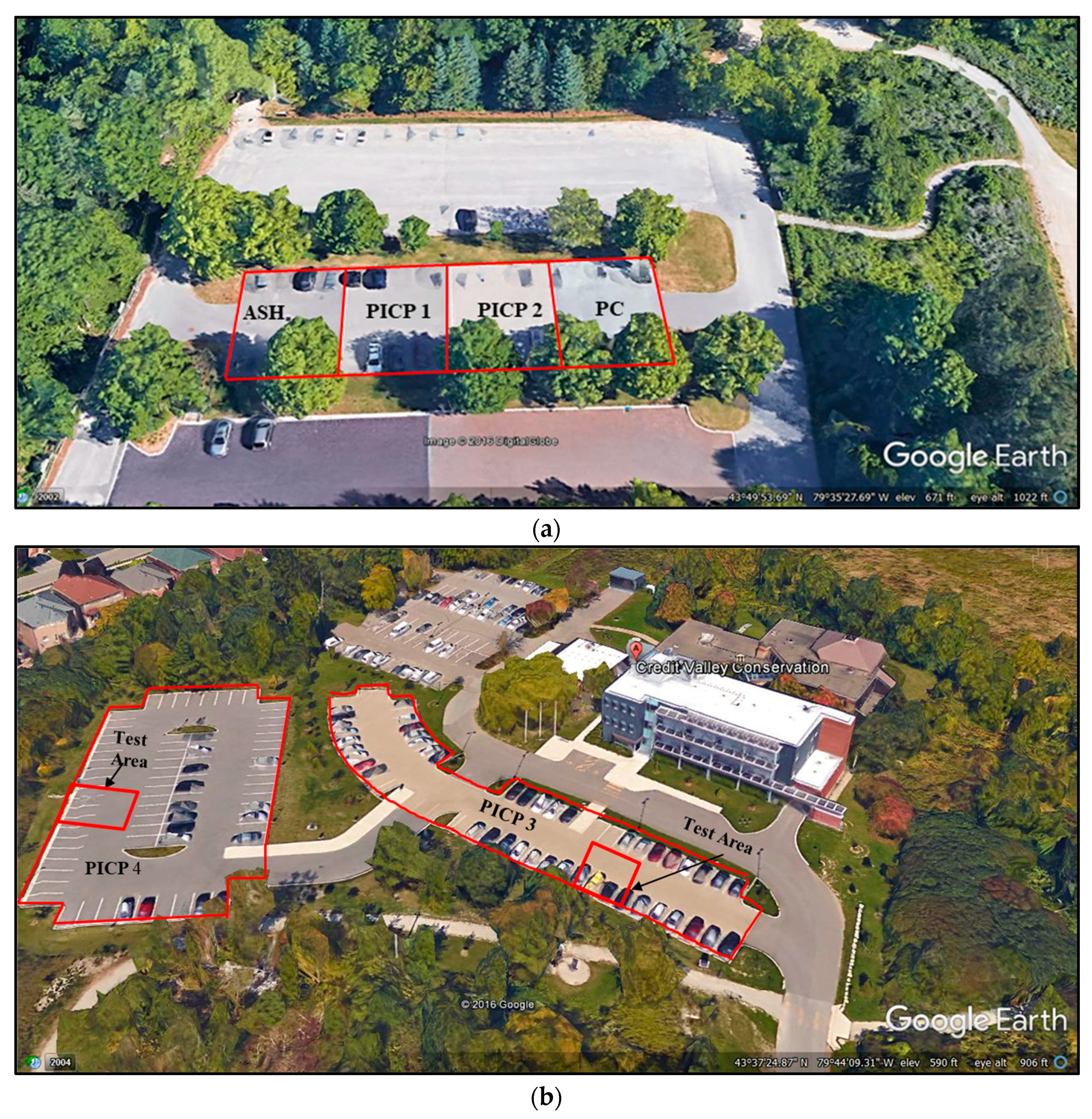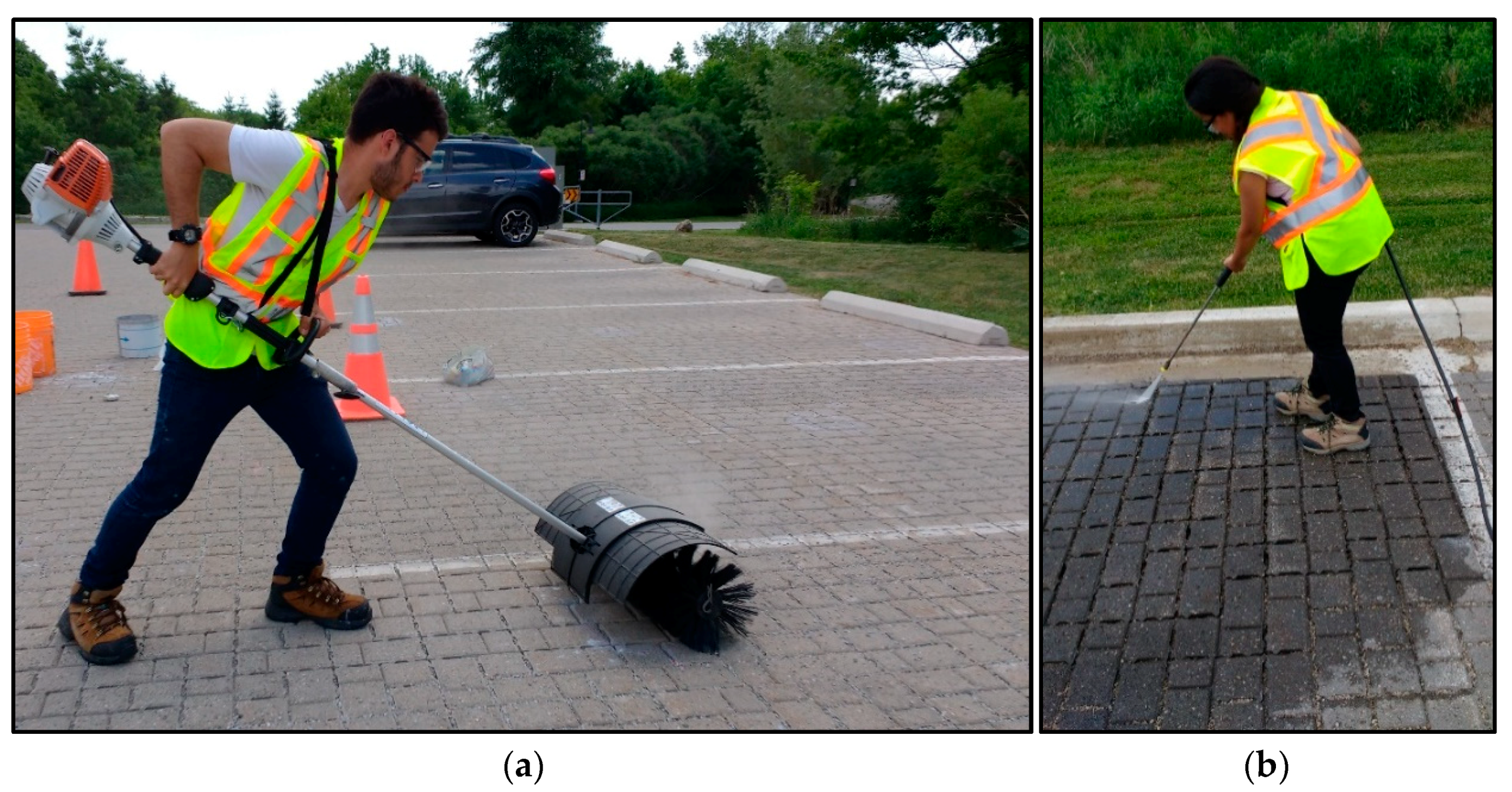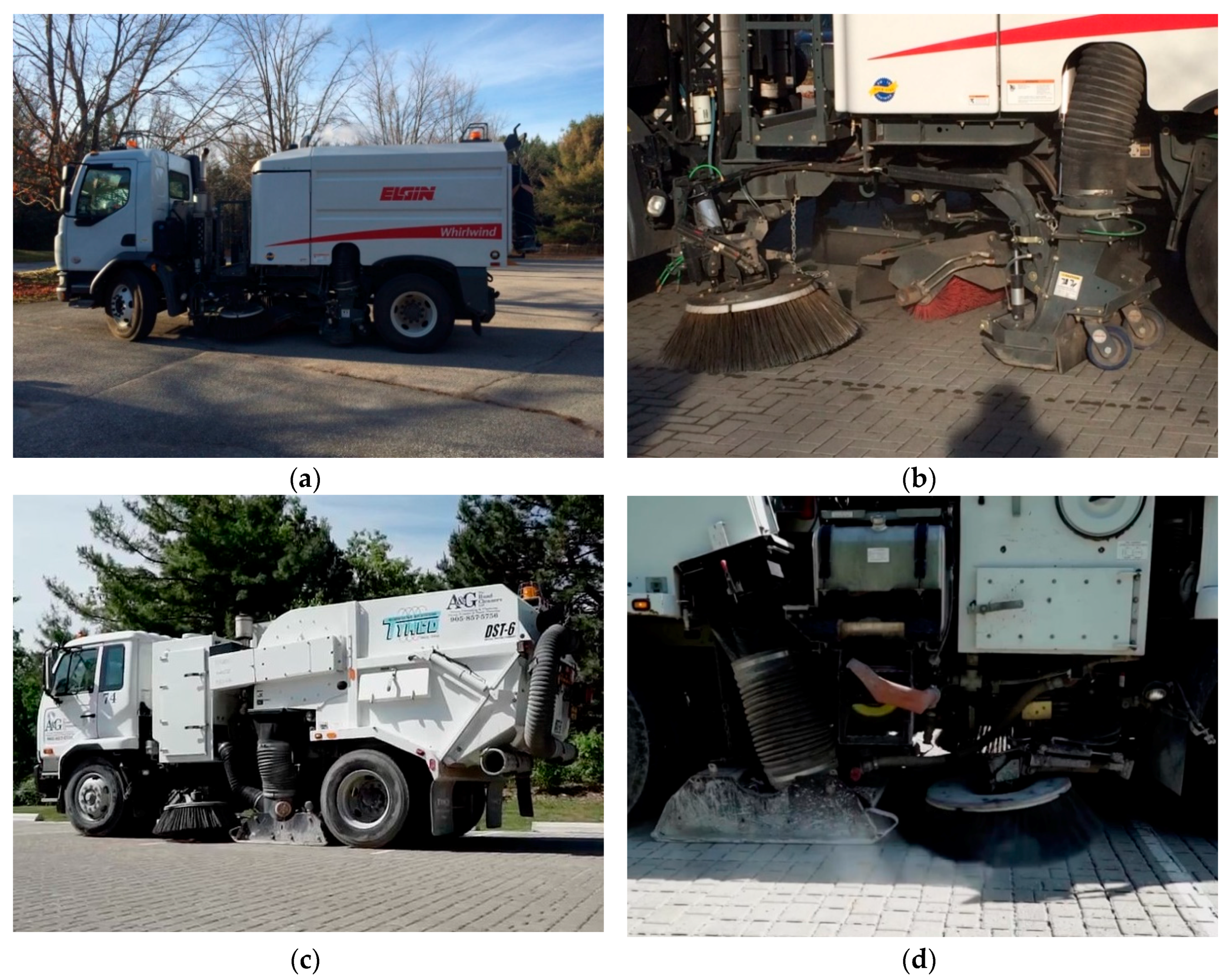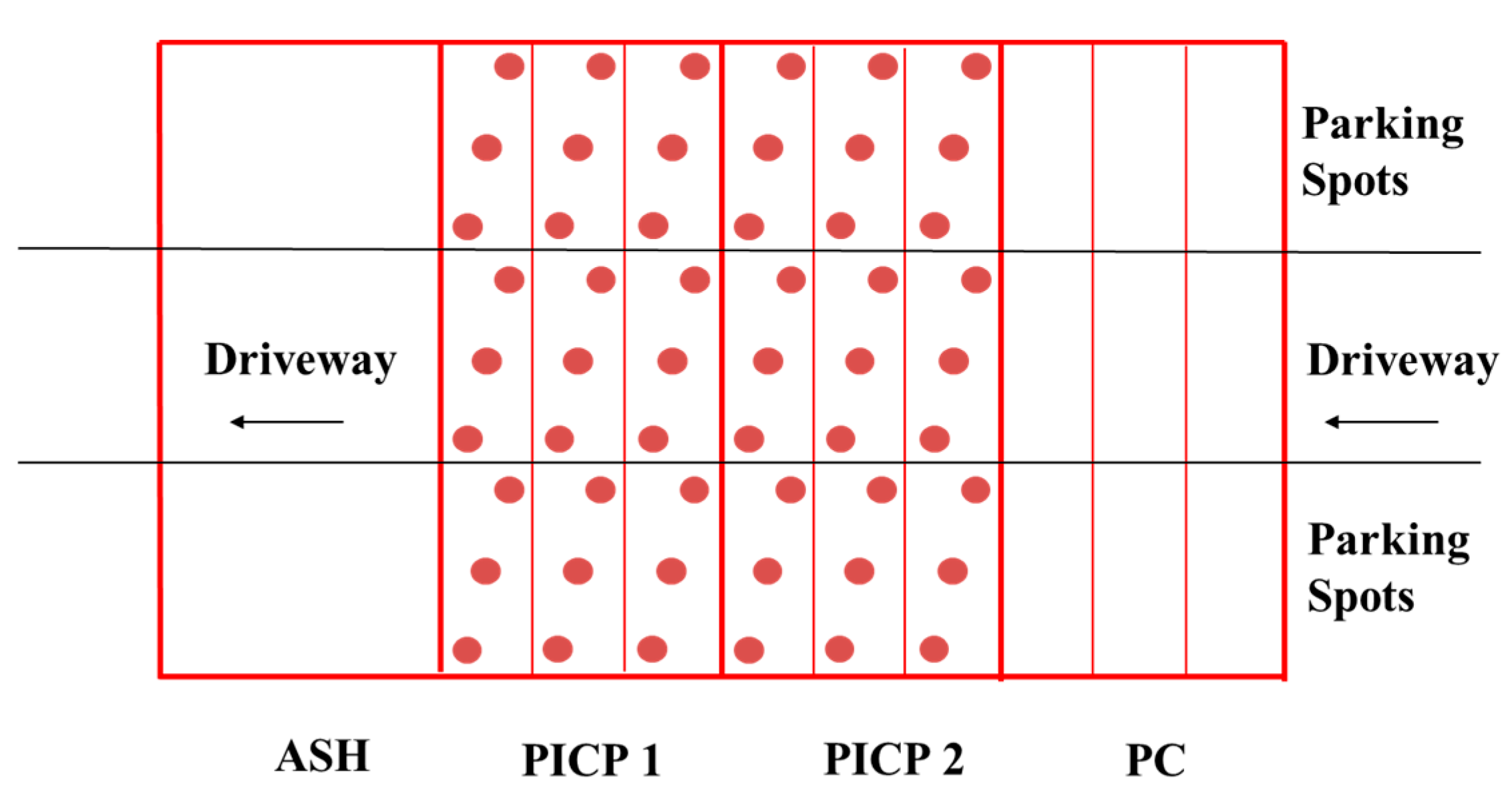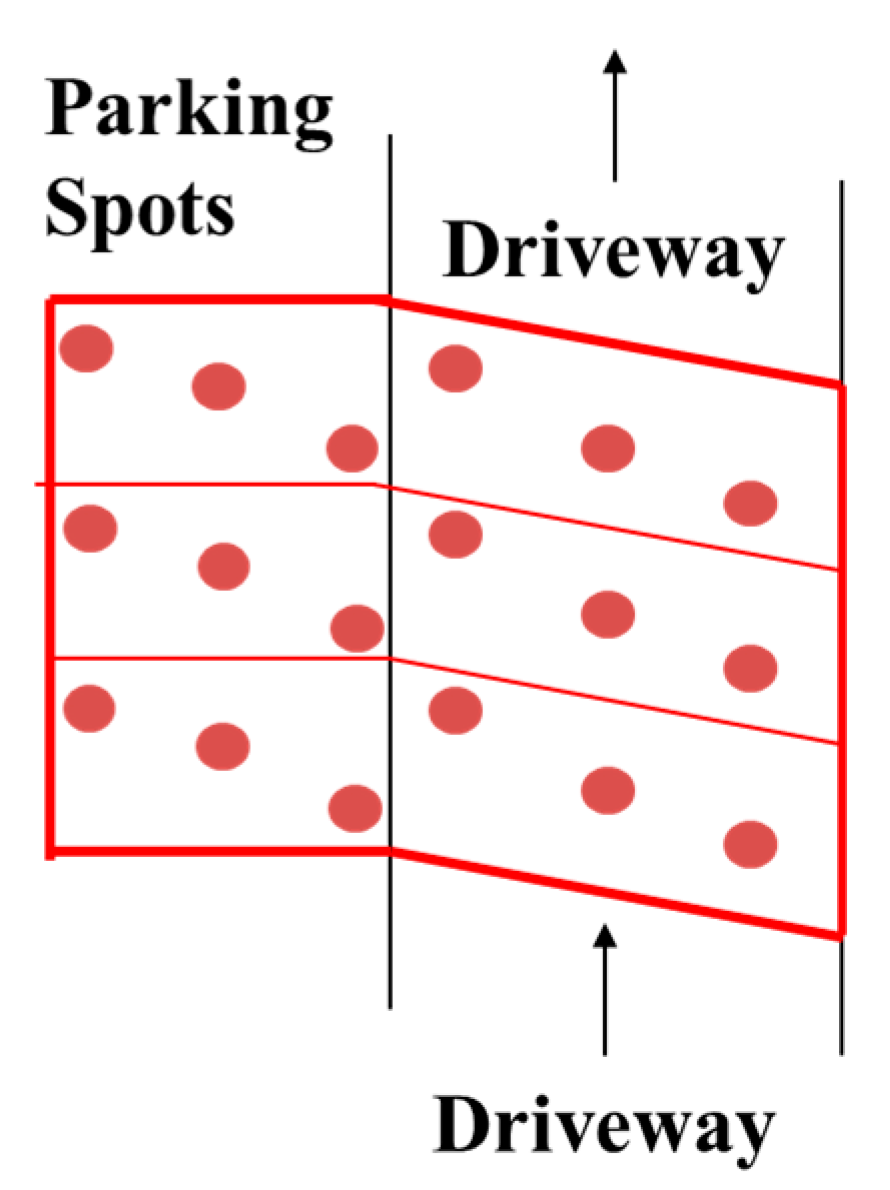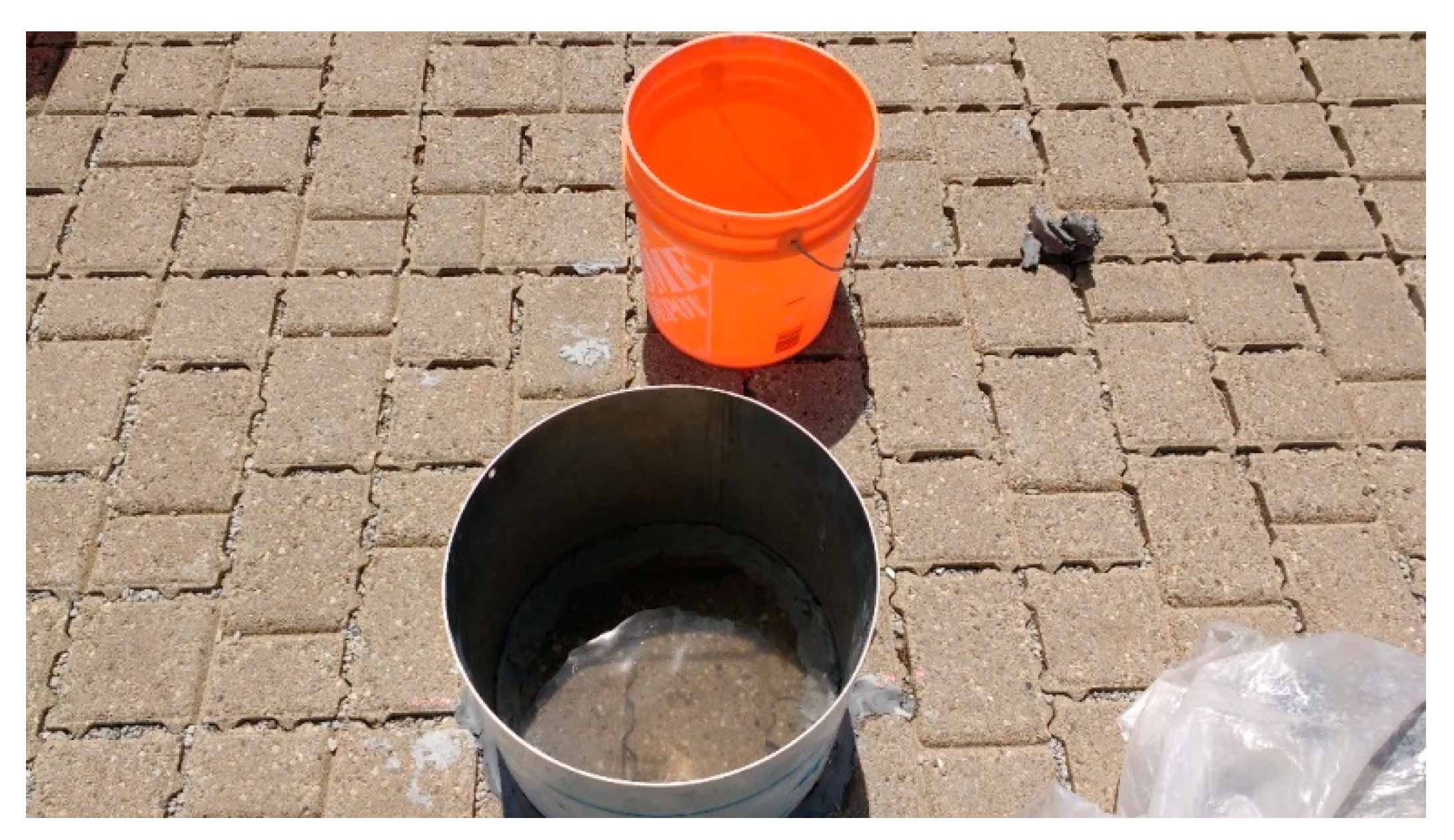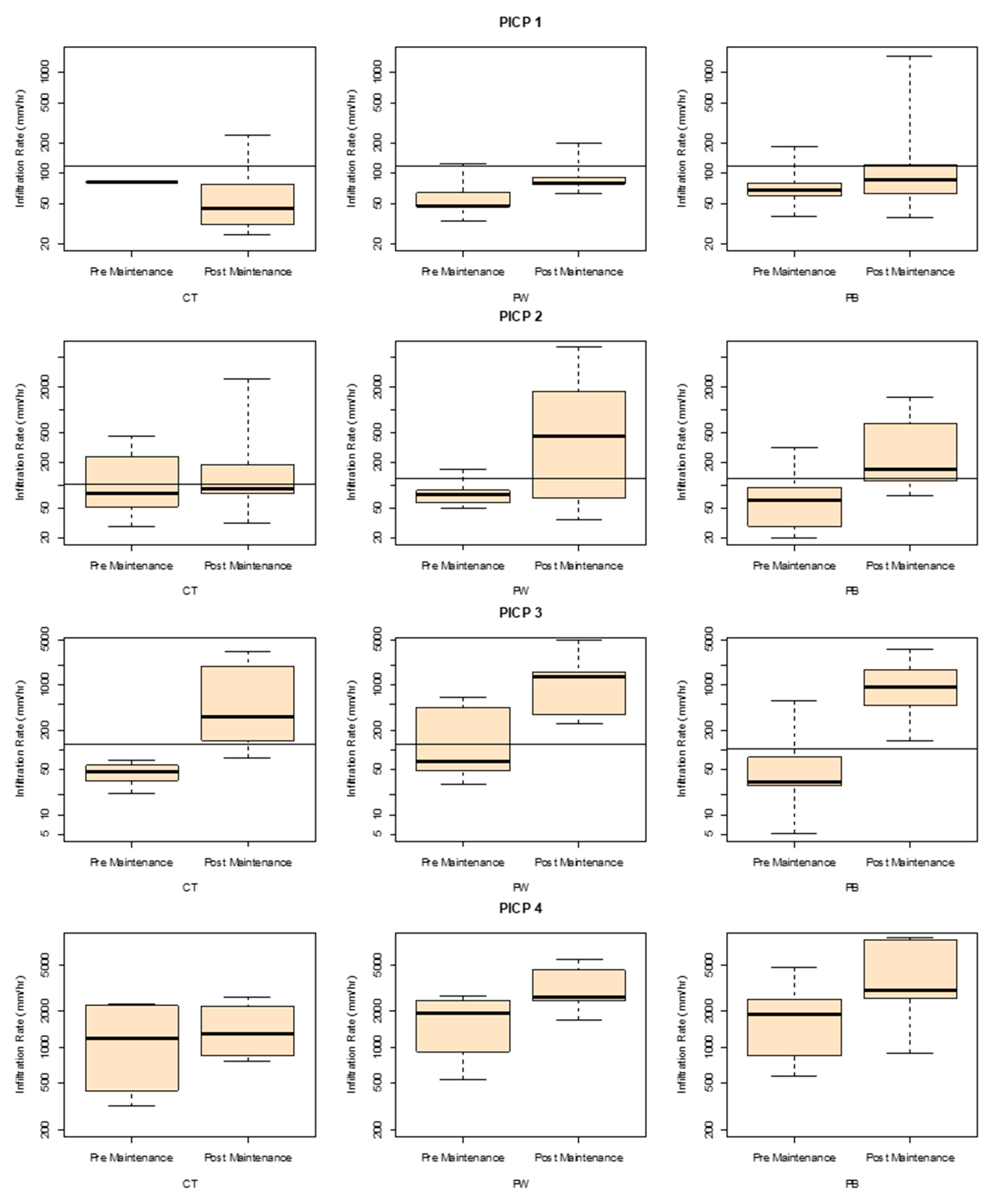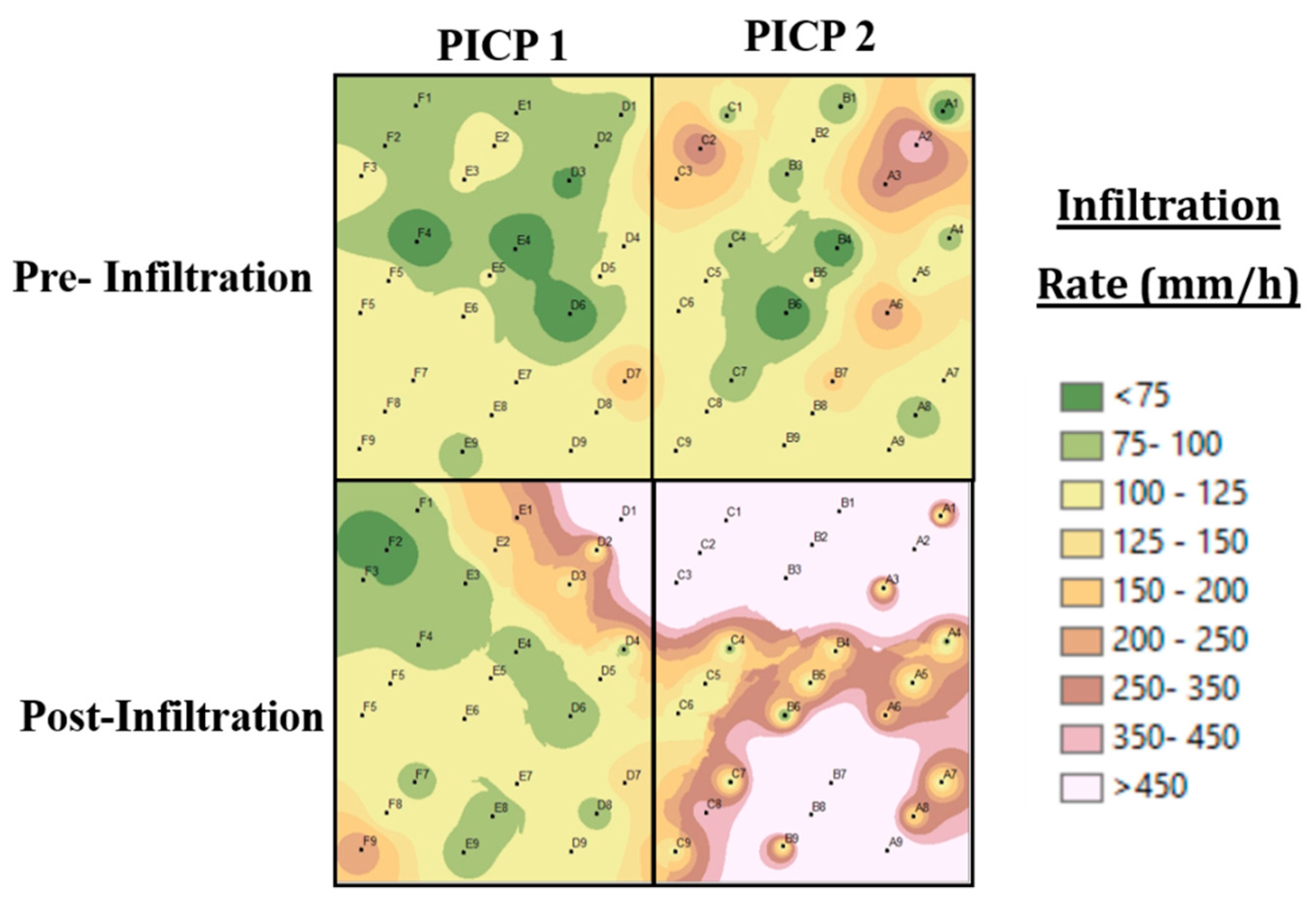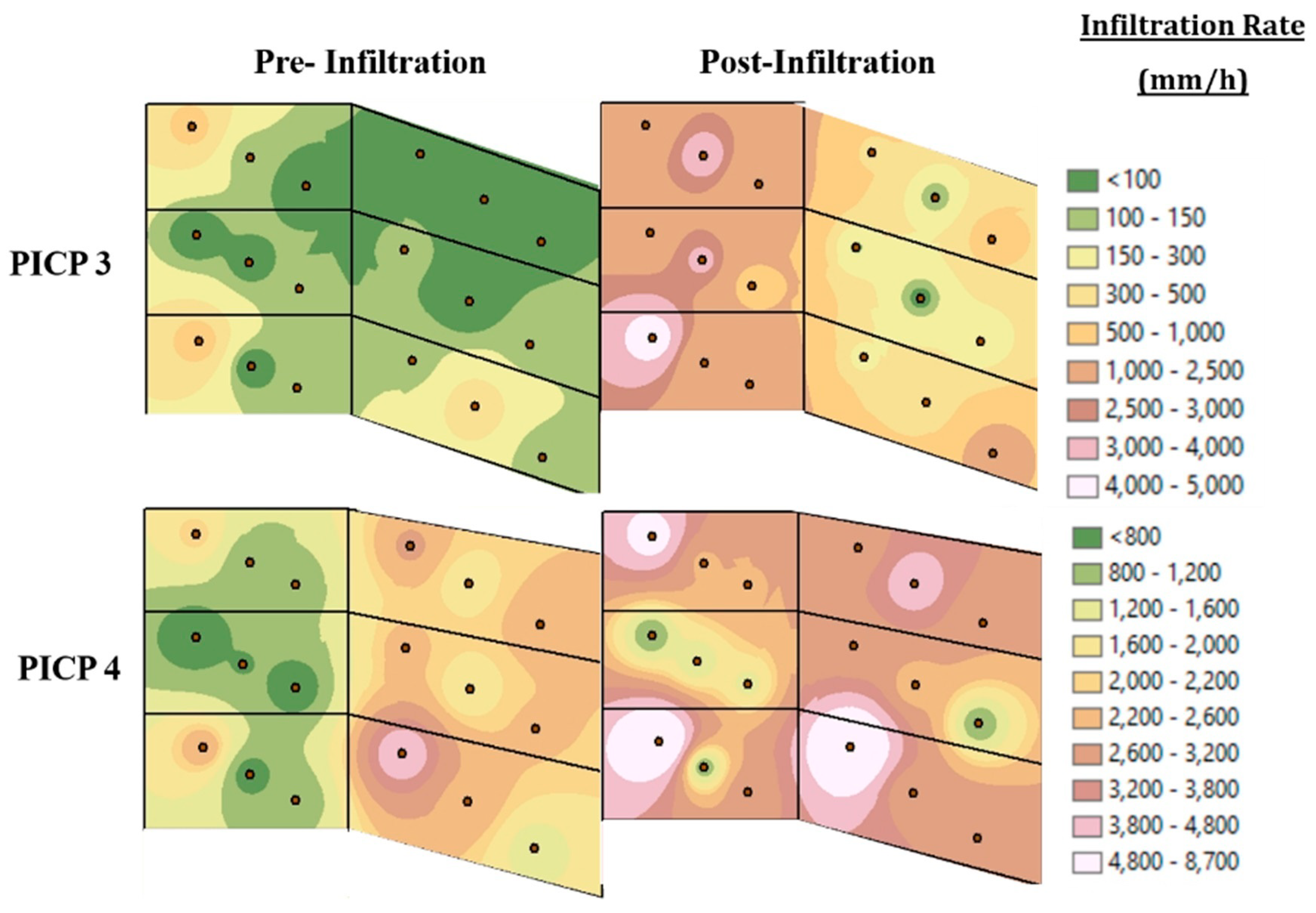1. Introduction
Permeable pavements (PP), specifically Permeable Interlocking Concrete Pavements (PICP), are becoming a widely adopted Low Impact Development (LID) technology [
1] in Canada and the United States. PICPs are masonry pavers with open joints that are filled with prewashed joint material. PICPs are a better stormwater management alternative in comparison to traditional impermeable pavements as they decrease the effective impervious area (EIA) of a catchment creating opportunities for infiltration and sustaining pre-development hydrologic conditions [
2,
3]. As an alternative hardscaping material, PICPs mitigate the negative impacts of urbanization by attenuating peak flows, increasing infiltration into the native soil and improving the quality of the water [
4]. The potential of permeable pavements to reduce pollutant load to rivers and streams has been demonstrated by several researchers in Canada [
5,
6,
7,
8], the United States [
3,
9,
10,
11,
12,
13], Europe [
2,
14,
15,
16] and Oceania [
17,
18]. The recognition of benefits has led to the adoption of permeable pavements for low traffic infrastructures like parking lot and sidewalks in the last two decades, and most Canadian and US municipalities use them for source control stormwater management.
Traditional impervious pavers have either polymeric sand sealed joints or they are laid in cement stabilized base. This results in an overall impervious surface and limits water percolation. In contrast, the joints in between the PICP are filled with a free draining material which aids in water percolation. Stormwater percolates through open joints and voids of permeable pavements to an underlying aggregate base [
7], providing a continuous path to enhance surface infiltration. The filtration through the aggregate base improves the quality of the infiltrate [
4]. A PICP cross section typically consists of seven distinct components: sub-base, base, bedding layer, joint material, underdrain, geotextile and paver blocks. In PICP, the sub-base, base and bedding layers consist of different size of aggregates which act as a reservoir as well as filtration media for the percolating stormwater.
The hydrologic benefits derived from permeable pavements have been well established in the last two decades by researchers in North America [
6,
7,
19,
20]. However, researchers have identified that over time the void spaces in permeable pavements become clogged with fines and debris, decreasing the pavement’s capacity to infiltrate stormwater [
21,
22,
23,
24]. Researchers [
21,
22,
23,
25] have tested different equipment for preventive and restorative maintenance of permeable pavements. The most prominent equipment are vacuum and regenerative air street sweepers which are commercially available and utilized by municipalities. Different types of street sweepers include mechanical, regenerative air and vacuum truck [
25]. Regenerative air sweeper and vacuum trucks apply suction on the surface to dislodge the dirt from the pavement joints, whereas mechanical sweepers only disperse debris from the surface of the pavement. A vacuum-sweeping truck operates at a speed of 1–3 km/h and a maximum power of 2500 rpm. It creates suction through a nozzle to remove debris [
21]. Regenerative air street sweepers, operating at a similar speed, produce power of 2000 rpm and are equipped with an air recycling system and a wider pickup head. Regenerative air street sweepers are increasingly replacing mechanical street sweepers in municipal fleets because they generate significantly less air pollution and remove finer sediment particles and associated pollutants from pavements.
Baladès et al. (1995), one of the pioneer researchers testing maintenance of permeable pavements, established that regular preventive maintenance is required to maintain the infiltration capacity of old permeable pavements, which can be accomplished by using street sweepers with suction. Restorative maintenance is conducted when the surface infiltration capacity has significantly reduced. Techniques like pressure washing have been effective in removal of fines from the PP joints [
22,
25]. Gerrits and James (2004) tested removal of material at different depths from the surface of permeable pavements and found maximum restoration of infiltration capacity by removing clogging material up to 15 mm from the surface. Subsequent removal did not cause a significant increase in the infiltration capacity. This can be achieved by using a standard street sweeping equipment for partial restoration of the infiltration capacity. Gerrits and James (2004) also observed the spatial variability in the infiltration capacity and found it to be lower in areas with high traffic load.
Kumar et al. (2016) observed surface degradation over four years for a parking lot consisting of three different types of permeable pavements with regular preventive maintenance and found that surface infiltration capacity decreased slightly (2–10%) throughout the first year. However, significant loss of infiltration capacity (82–90%) was observed in the subsequent years and more substantial loses in infiltration capacity were associated with high traffic areas like the driveways. The study utilized preventative maintenance by using gentle water spray followed by rotary brush sweeping twice a year which produced substantial benefits as a preventative maintenance practice. Kumar et al. (2016) recommended maintenance of permeable pavements using suction sweeping or pressure washing followed by suction sweeping for the restoration of infiltration capacity. There is, however, a dearth of literature experimenting on restorative maintenance with older PICP parking lots, which are increasingly common across municipalities.
Winston et al. (2016) assessed the effectiveness of different maintenance practices to restore PP surface infiltration capacity on nine permeable pavements (poured and pavers) ranging from 0.5 to 28 years old in North America and Europe using maintenance practices like manual removal of the upper 2 cm of fill material, mechanical street sweeping, regenerative-air street sweeping, vacuum street sweeping, hand-held vacuuming, high pressure washing, and milling of porous asphalt. Winston et al. (2016) concluded that street sweepers using suction action were more effective than mechanical sweepers for PICP maintenance.
The Interlocking Concrete Pavement Institute (ICPI) recommends a minimum infiltration capacity of 250 mm/h (Smith 2011) for effective operation of PICP installations. As the use of PICPs increases, practical and effective maintenance practices will become increasingly important. A lack of standardized and proven maintenance techniques inhibits the growth of PICP as a stormwater management practice. Current literature reveals that preventative maintenance helps to preserve the infiltration capacity and reduces the need to adopt restorative maintenance techniques in the long term. However, a lot of old PICP parking lots exist across the Greater Toronto Area which were initially neglected and need restoration of their infiltration capacity. The objective of this study was to evaluate surface treatment technologies including a hand-held power-brush and pressure washer when used in combination with a vacuum-based street sweeper for restoring the infiltration capacity of mature permeable pavement installations and to determine if power brush and/or pressure washer improve the effectiveness of street sweeping. The goal of this work is to develop new restorative maintenance techniques and improve Best Management Practices (BMPs) to restore the hydraulic functionality of mature PICP installations.
4. Conclusions
Permeable interlocking concrete pavements (PICP) have been recognized as an effective stormwater management practice. However, over time, the joint spaces which allow stormwater to infiltrate through the pavement surface become clogged with fines and sediments. Effective maintenance technologies, both preventive and restorative, are required to maintain or rejuvenate the hydrologic benefits of aging permeable pavements. This study investigated whether using the surface treatments in combination with vacuum-based street sweeping provided significant benefits over using only street sweepers.
Surface treatments with the power brush and pressure washer made it easier for the vacuum action of the street sweeper at newer installations to remove joint material with less usage intensity. Pavement age, joint space and usage intensity greatly influenced the overall effectiveness of all maintenance combinations. A mature PICP section, PICP 1, with small joint spacing was heavily clogged and effective restorative maintenance could not be achieved. This section was similar in pavement structure, that is, base and sub-base, to PICP 2 with difference in joint opening size due to difference in product and placement of a geotextile layer. Mature pavement sections, PICP 2 and 3 with larger joint openings, demonstrated some improvement with pressure washing followed by vacuum-based street sweeping. Substantial improvement in infiltration capacity was achieved for the newer PICP section, PICP 4, that was not subjected to intense traffic loads. Overall pressure wash with vacuum sweeping was shown to be an effective approach for rejuvenating PICP sections with larger joint space. Power brush showed some improvement in infiltration capacity, but the results were inconsistent as significant sections of the pavements remained clogged. The median infiltration capacity for the least clogged section, PICP 4, improved by 62% and the highest infiltration capacity was measured as 8700 mm/h. For mature parking lots, that is, PICP 1, maintenance resulted in an increase in infiltration rate to 80 mm/h which is well below the 250 mm/h recommended minimum infiltration rate by ICPI (Smith 2011). Thus, it is recommended that a combination of pressure washing along with vacuum sweeping, adopted earlier in the pavement life, would help in maintaining high levels of infiltration.
